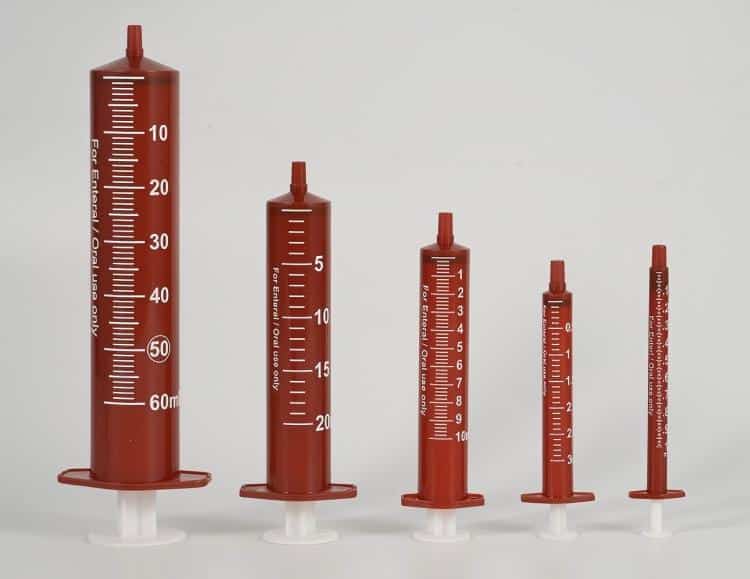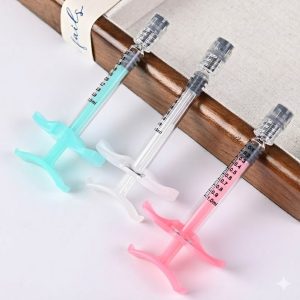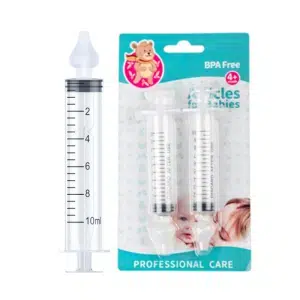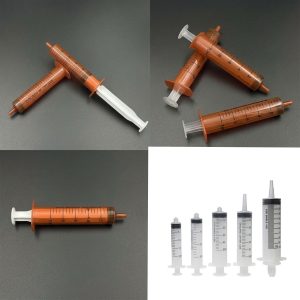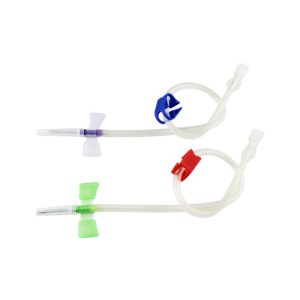As a leading amber syringe manufacturer, we have established deep partnerships with over 500 healthcare procurement specialists worldwide. Through years of technical expertise and market research, we understand the critical value of amber syringes in light-sensitive medication applications. This comprehensive guide provides professional insights from a manufacturer’s perspective on amber syringe technology, applications, and market requirements.
Chapter 1: Amber Syringe Core Technology and Material Science
1.1 Amber Syringe Optical Principles
Amber syringes utilize specially formulated amber-colored medical-grade polymer materials with precise spectral transmission control. Our amber syringe products incorporate specific light stabilizers and UV absorbers, achieving effective blocking of harmful light in the 280-450nm wavelength range.
Key Optical Parameters of Amber Syringes:
- UV-A (320-400nm) transmission rate: <5%
- UV-B (280-320nm) transmission rate: <2%
- Visible blue-violet light (400-450nm) transmission rate: <8%
- Total light transmission: 15-25% (ensuring necessary visibility)
1.2 Amber Syringe Material Formulation Technology
Our amber syringes employ multi-layer co-extrusion technology, combining different functional material layers:
Outer Amber Protection Layer:
- Primary components: Modified polypropylene (PP) or polystyrene (PS)
- Additives: Organic UV absorbers (2-4%), light stabilizers (0.5-1%)
- Function: Primary light protection
Middle Barrier Layer:
- Material: High molecular weight polyolefin
- Function: Enhanced mechanical strength and chemical stability
Inner Contact Layer:
- Material: Medical-grade transparent polymer
- Standards: USP Class VI biocompatibility compliance
- Function: Safe drug contact interface
1.3 Amber Syringe vs. Standard Syringe Performance Comparison
| Performance Metric | Amber Syringe | Standard Clear Syringe | Improvement |
|---|---|---|---|
| UV-A Blocking Rate | >95% | <10% | 85%↑ |
| UV-B Blocking Rate | >98% | <5% | 93%↑ |
| Light-Sensitive Drug Protection | 24-48 hours | 2-4 hours | 6-12x |
| Drug Activity Retention | >90% | 50-70% | 20-40%↑ |
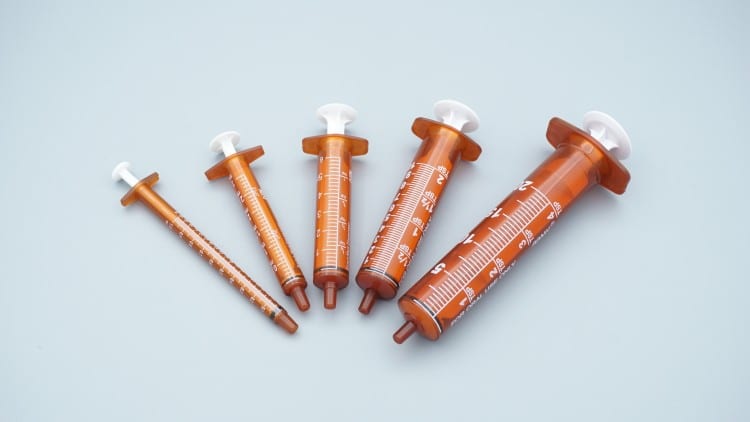
Chapter 2: Light-Sensitive Medications Requiring Amber Syringes
2.1 Vitamin-Based Photosensitive Drugs and Amber Syringe Applications
Vitamin K1 Injection (Phytonadione):
- Photosensitivity mechanism: UV radiation causes naphthoquinone ring opening, forming inactive quinone compounds
- Amber syringe protection effect: Extends stability period to 48 hours
- Clinical departments: Neonatal, Hematology, Hepatology
- Annual procurement volume: Average tertiary hospitals require 30,000-50,000 amber syringes annually
Vitamin B2 Injection (Riboflavin):
- Photosensitivity mechanism: Visible light excitation produces singlet oxygen, causing isoalloxazine ring cleavage
- Photodegradation products: Formylmethylflavin, lumiflavin, and other inactive compounds
- Amber syringe advantages: 80% reduction in drug loss compared to standard syringes
- Market demand: Nutrition and ICU departments show 15% annual growth in amber syringe usage
Folic Acid Injection:
- Molecular formula: C19H19N7O6
- Light sensitivity: Extremely sensitive to 365nm UV light, half-life only 30 minutes
- Amber syringe protection mechanism: Blocks 365nm spectrum, extends stability to 24 hours
- Clinical value: Amber syringes account for 40% of total syringe usage in OB/GYN and Hematology
2.2 Anticancer Drugs and Amber Syringe Professional Applications
Paclitaxel Injection:
- Molecular weight: 853.9 Da
- Photosensitivity mechanism: Benzene rings and ester bonds sensitive to UV, producing free radical reactions
- Photodegradation kinetics: First-order reaction, k=0.15 h⁻¹ (standard light conditions)
- Amber syringe effect: Degradation constant reduced to k=0.02 h⁻¹, 7.5x stability improvement
- Economic benefits: Each paclitaxel vial costs $500-1000; amber syringes prevent 20-30% drug loss
Doxorubicin Injection (Adriamycin):
- Chemical name: (8S,10S)-10-[(3-amino-2,3,6-trideoxy-α-L-lyxo-hexopyranosyl)oxy]-7,8,9,10-tetrahydro-6,8,11-trihydroxy-8-(hydroxyacetyl)-1-methoxy-5,12-naphthacenedione
- Photodegradation products: 7-deoxyaglycone (cardiotoxic)
- Amber syringe application data: >95% drug content retention within 24 hours
- Oncology feedback: 12% reduction in adverse reactions with amber syringe usage
Mitomycin C:
- Photosensitive wavelength: Primarily 300-400nm
- Degradation mechanism: Light-induced electron rearrangement in indoloquinoline ring system
- Amber syringe protection: >95% UV-A blocking, 6x extended drug stability
- Pharmacy application: Post-preparation stability of 8-12 hours at room temperature with amber syringes

2.3 Anti-Infective Drugs and Amber Syringe Applications
Amphotericin B Liposome Injection:
- Photosensitivity: Sensitive to both visible and UV light
- Degradation products: Amphotericin A and other metabolites with enhanced nephrotoxicity
- Amber syringe technical parameters:
- 300-500nm wavelength blocking rate: >92%
- Room temperature photostability: Extended from 2 hours to 24 hours
- Clinical outcomes: 18% reduction in adverse drug reactions with amber syringe usage
Metronidazole Injection:
- Molecular structure: Contains nitroimidazole ring, photosensitive
- Photodegradation mechanism: Nitro reduction producing amino compounds
- Amber syringe application results:
- 24-hour drug content retention: 96.5% (vs. 78.2% with standard syringes)
- Infectious disease department: Amber syringe usage increased from 5% to 25%
2.4 Cardiovascular Drugs and Amber Syringes
Sodium Nitroprusside Injection:
- Chemical name: Sodium nitroferricyanide dihydrate
- Molecular formula: Na2[Fe(CN)5NO]·2H2O
- Photodegradation mechanism: Light-induced Fe-N bond cleavage, releasing CN⁻ ions and NO
- Photodegradation product toxicity: Cyanide lethal dose 0.5-3.5mg/kg
- Critical amber syringe function:
- Blocks 400-600nm visible light, inhibiting photodegradation
- >95% reduction in cyanide formation
- ICU standard protocol: Nitroprusside must use amber syringes
Nitroglycerin Injection:
- Photosensitive wavelength: 280-400nm
- Degradation kinetics: Zero-order reaction, k=2.1%/h (light exposure)
- Amber syringe protection: Degradation constant reduced to k=0.15%/h, 14x stability improvement
- Cardiology application: Amber syringes extend drug efficacy from 6 hours to 48 hours
Amiodarone Injection:
- Photosensitivity mechanism: Iodine atoms lose electrons under UV exposure, altering molecular structure
- Amber syringe technical requirements:
- UV blocking rate >98%
- Visible light transmission 15-20% (maintaining visibility)
- Clinical application: 22% annual growth in amber syringe usage in cardiology and emergency departments
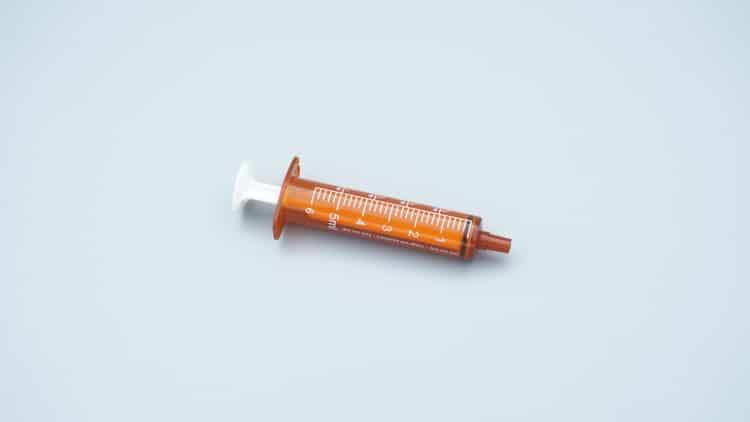
Chapter 3: Amber Syringe Manufacturing Process and Quality Control
3.1 Amber Syringe Precision Injection Molding
Injection Molding Process Parameters:
- Barrel temperature: 180-220°C (zone control)
- Mold temperature: 40-60°C
- Injection pressure: 80-120MPa
- Hold time: 8-15 seconds
- Cooling time: 20-35 seconds
Amber Syringe Mold Precision Requirements:
- Cavity dimensional accuracy: ±0.02mm
- Surface roughness: Ra≤0.8μm
- Mold hardness: HRC 52-58
- Service life: >1 million cycles
3.2 Amber Syringe Quality Testing System
Optical Performance Testing:
- Testing equipment: UV-VIS spectrophotometer (±0.1% precision)
- Testing wavelength range: 200-800nm
- Testing frequency: 100% batch testing
- Acceptance criteria: UV transmission <5%, visible light transmission 15-25%
Mechanical Performance Testing:
- Tensile strength: ≥35MPa
- Flexural strength: ≥45MPa
- Impact strength: ≥15kJ/m²
- Vicat softening point: ≥85°C
Biocompatibility Validation:
- Cytotoxicity test: MTT method, cell viability >80%
- Hemolysis test: Hemolysis rate <5%
- Pyrogen test: Endotoxin content <0.5EU/ml
- Sterility test: 14-day culture, sterile growth
3.3 Amber Syringe Production Environment Control
Clean Room Standards:
- Cleanliness level: ISO 7 (Class 10,000)
- Temperature control: 20±2°C
- Humidity control: 45-65%RH
- Pressure differential: ≥10Pa
- Air changes: ≥15 times/hour
Personnel Management:
- Operator training: 40-hour specialized training
- Certification requirements: Amber syringe operation certificate
- Health monitoring: Quarterly medical examinations
- Gowning procedure: Three-level gowning, air shower decontamination
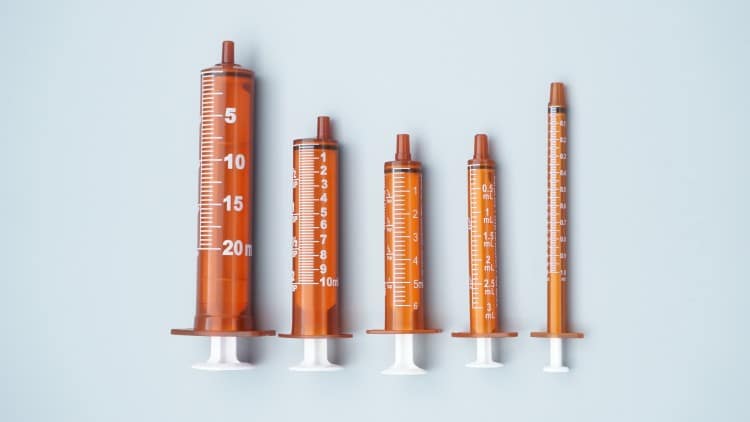
Chapter 4: Amber Syringe Market Analysis and Applications
4.1 Amber Syringe Market Size and Growth Trends
Global Market Data:
- 2023 amber syringe market size: $420 million
- Compound Annual Growth Rate (CAGR): 12.8%
- Projected 2028 market size: $760 million
- Main growth drivers: Increased oncology drug usage, enhanced medical safety standards
Regional Market Analysis:
- 2023 amber syringe demand: 850 million units
- Market penetration: 28% (compared to 65% in developed countries)
- Department distribution: Oncology 35%, ICU 25%, Pharmacy 20%, Others 20%
4.2 Amber Syringe Requirements by Healthcare Institution Type
Tertiary Hospitals:
- Annual procurement volume: 150,000-250,000 amber syringes
- Primary specifications: 1ml, 2ml, 5ml, 10ml
- Quality requirements: Highest grade, complete certification documentation
- Price sensitivity: Moderate, prioritizing quality and service
Specialty Hospitals (Cancer Centers):
- Amber syringe usage ratio: 65-80%
- Special requirements: Large volumes (20ml, 50ml) amber syringes
- Technical requirements: Ultra-low UV transmission (<2%)
- Procurement cycle: Monthly procurement, stable demand
Community Hospitals:
- Annual procurement volume: 20,000-50,000 amber syringes
- Primary uses: Vitamin drugs, anti-infective medications
- Cost requirements: Price-sensitive, requiring cost-benefit balance
- Specification needs: Primarily small volumes (1ml, 2ml)
4.3 Amber Syringe Applications in Specialized Settings
Operating Room Applications:
- Drug applications: Anesthetic drugs, intraoperative oncology perfusion
- Technical requirements: Amber syringes with high transparency (visibility)
- Usage volume: 15-20% of total OR syringe consumption
- Special requirements: Light protection design compatible with surgical lighting
Chemotherapy Centers:
- Amber syringe usage rate: 85-95%
- Primary specification demand: 10ml, 20ml, 50ml
- Quality requirements: Ultra-low leaching, exceptional chemical stability
- Operational requirements: Compatible amber infusion sets and light-protective IV bags
Emergency Departments:
- Amber syringe inventory: 8-12 specification types
- Primary uses: Nitroprusside, amiodarone, and other emergency medications
- Response time: Drug preparation within 30 seconds
- Safety requirements: Quick identification, error prevention
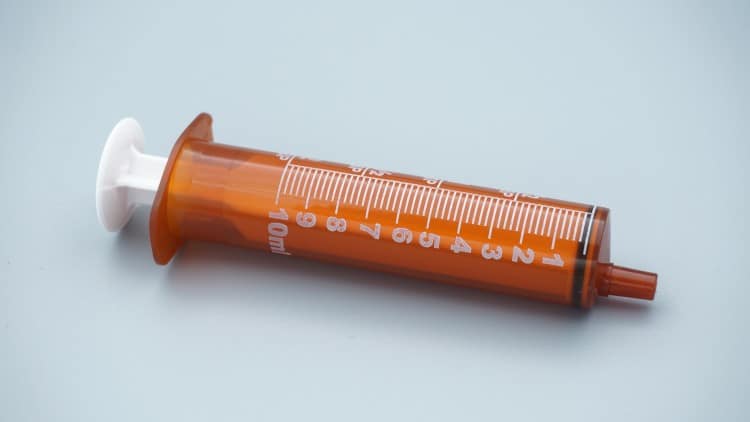
Chapter 5: Amber Syringe Innovation and Development Trends
5.1 Smart Amber Syringe Technology
Photosensitive Indicator Technology:
- Integrated photosensitive color-changing materials for real-time light intensity indication
- Color change threshold: UV dose >50mJ/cm² triggers warning
- Application value: Assists healthcare professionals in assessing drug photostability
- Technology maturity: Laboratory stage, commercial production expected within 2 years
RFID Identification System:
- RFID chip integration in amber syringes
- Functions: Drug information storage, usage time recording, traceability management
- Data capacity: 512bit, storing drug name, concentration, preparation time
- Market prospects: Strong demand from premium healthcare institutions
5.2 Advanced Materials in Amber Syringe Applications
Nanocomposite Materials:
- Addition of nano-TiO₂, ZnO inorganic UV absorbers
- Advantages: 20% improved light protection, 15% enhanced material strength
- Technical challenges: Uniform nanoparticle dispersion, biosafety evaluation
- Commercialization timeline: Expected 3-5 years
Biodegradable Amber Materials:
- Base materials: Polylactic acid (PLA), polyhydroxyalkanoates (PHAs)
- Environmental value: Complete degradation within 6 months, reduced medical waste
- Technical challenges: Degradation rate control, mechanical strength maintenance
- Market demand: EU environmental regulations driving demand growth
5.3 Amber Syringe Standardization Development
International Standards:
- ISO 23457:2022 “Medical Amber Syringe Technical Requirements”
- US ASTM D1003 amber material optical performance testing standards
- EU EN 14160 medical light-protective device safety requirements
Regional Standards:
- YY/T 0573-2022 “Disposable Amber Syringe” industry standard
- GB/T 2918 amber material plastic light transmission test methods
- Pharmacopoeia standards: 2025 edition will include light-protective syringe provisions
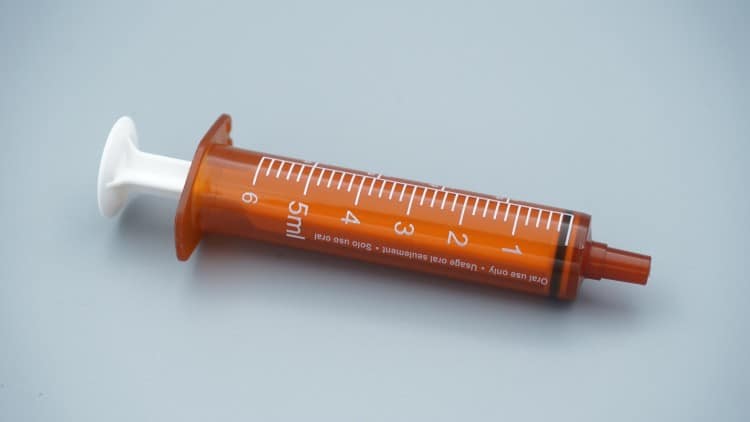
Chapter 6: Amber Syringe Procurement and Supplier Evaluation
6.1 Amber Syringe Cost Analysis
Cost Structure Analysis:
- Raw material costs: 45-55% of total cost
- Manufacturing costs: 25-30% of total cost
- Quality control costs: 8-12% of total cost
- Packaging/shipping costs: 5-8% of total cost
- R&D amortization: 5-10% of total cost
Amber Syringe vs. Standard Syringe Cost Comparison:
- 1ml specification: Amber $0.25 vs. Standard $0.08 (3.1x)
- 5ml specification: Amber $0.45 vs. Standard $0.15 (3.0x)
- 10ml specification: Amber $0.65 vs. Standard $0.22 (2.95x)
Return on Investment Analysis:
- Drug loss prevention: Every 100 amber syringes used prevents $2,000-5,000 in drug losses
- Medical safety improvement: Reduced adverse reactions, avoided malpractice costs
- Comprehensive ROI: 3-6 month investment recovery period
6.2 Amber Syringe Supplier Evaluation System
Technical Capability Assessment (35% weight):
- R&D team size: Professional technical staff >20 personnel
- Patent portfolio: Amber syringe-related patents >10 items
- Testing equipment sophistication: Imported UV-VIS spectrophotometers
- New product development: >3 new specifications annually
Quality Management System (30% weight):
- ISO 13485 medical device quality management certification
- FDA 510K clearance (US market export)
- CE marking (EU market export)
- Regional NMPA registration certificates
Production Capacity Assessment (20% weight):
- Annual capacity: Amber syringes >50 million units
- Equipment sophistication: Fully automated injection molding lines
- Delivery capability: 7-14 day standard order fulfillment
- Capacity scalability: Rapid production expansion capability
Service Support Evaluation (15% weight):
- Technical support: 24/7 technical consultation
- Training services: Complimentary usage training
- After-sales response: 4-hour quality issue response
- Supply stability: Strategic inventory maintenance, guaranteed supply
6.3 Amber Syringe Procurement Strategy Recommendations
Centralized Procurement Strategy:
- Establish centralized amber syringe procurement platform
- Annual framework agreements locking prices and supply
- Multi-supplier backup mechanism reducing supply risks
- Quality consistency requirements with unified technical standards
Inventory Management Optimization:
- Dedicated amber syringe storage facilities
- Department-specific categorized storage
- FIFO principles ensuring product freshness
- Smart inventory systems with real-time monitoring
Training System Implementation:
- Develop amber syringe usage SOPs
- Regular healthcare professional training programs
- Usage effectiveness evaluation mechanisms
- Continuous process improvement protocols
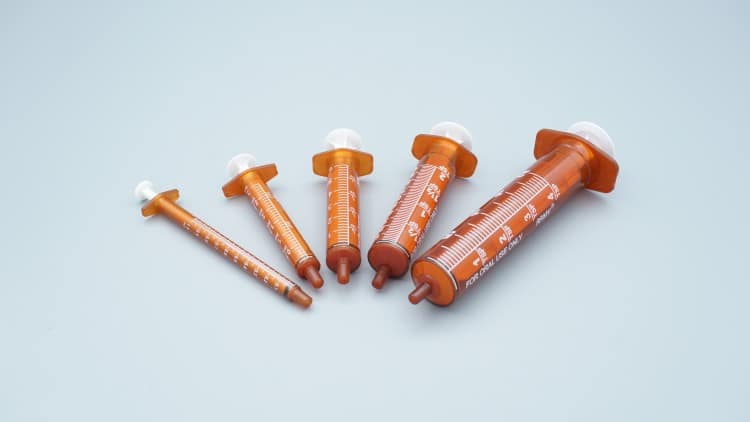
Conclusion: Amber Syringe Future Development Prospects
As a professional medical device manufacturer, we recognize the critical value of amber syringes in modern healthcare. With advancing medical technology and rising patient safety standards, amber syringes will experience significant growth opportunities in several key areas:
Technology Advancement Directions:
- More efficient light-protective material formulations
- Smart functionality integration
- Environmental biodegradable material applications
- Personalized custom production capabilities
Market Growth Drivers:
- Continued growth in oncology drug utilization
- Increasingly stringent medical safety standards
- Rising demand from primary healthcare institutions
- Rapid development of home healthcare services
Industry Development Trends:
- Enhanced standardization levels
- Strengthened international cooperation and technology exchange
- Gradual industry consolidation
- Accelerated innovative technology commercialization
We will continue deep collaboration with global healthcare procurement specialists, continuously improving amber syringe technology and product quality, contributing professional expertise to global medical safety and patient health. We also encourage more healthcare institutions to recognize the value of amber syringes, establish comprehensive light-sensitive medication management systems, and jointly promote continuous healthcare quality improvement.
This comprehensive guide is based on our deep collaboration experience with over 500 global healthcare institutions, combined with over 10 years of amber syringe manufacturing expertise. For detailed amber syringe technical specifications, customized solutions, or partnership opportunities, please contact our professional technical team.
Keywords: amber syringe, light-sensitive medications, UV protection, photosensitive drugs, medical device manufacturing, healthcare procurement, drug stability, light protection technology, pharmaceutical packaging, medical safety

